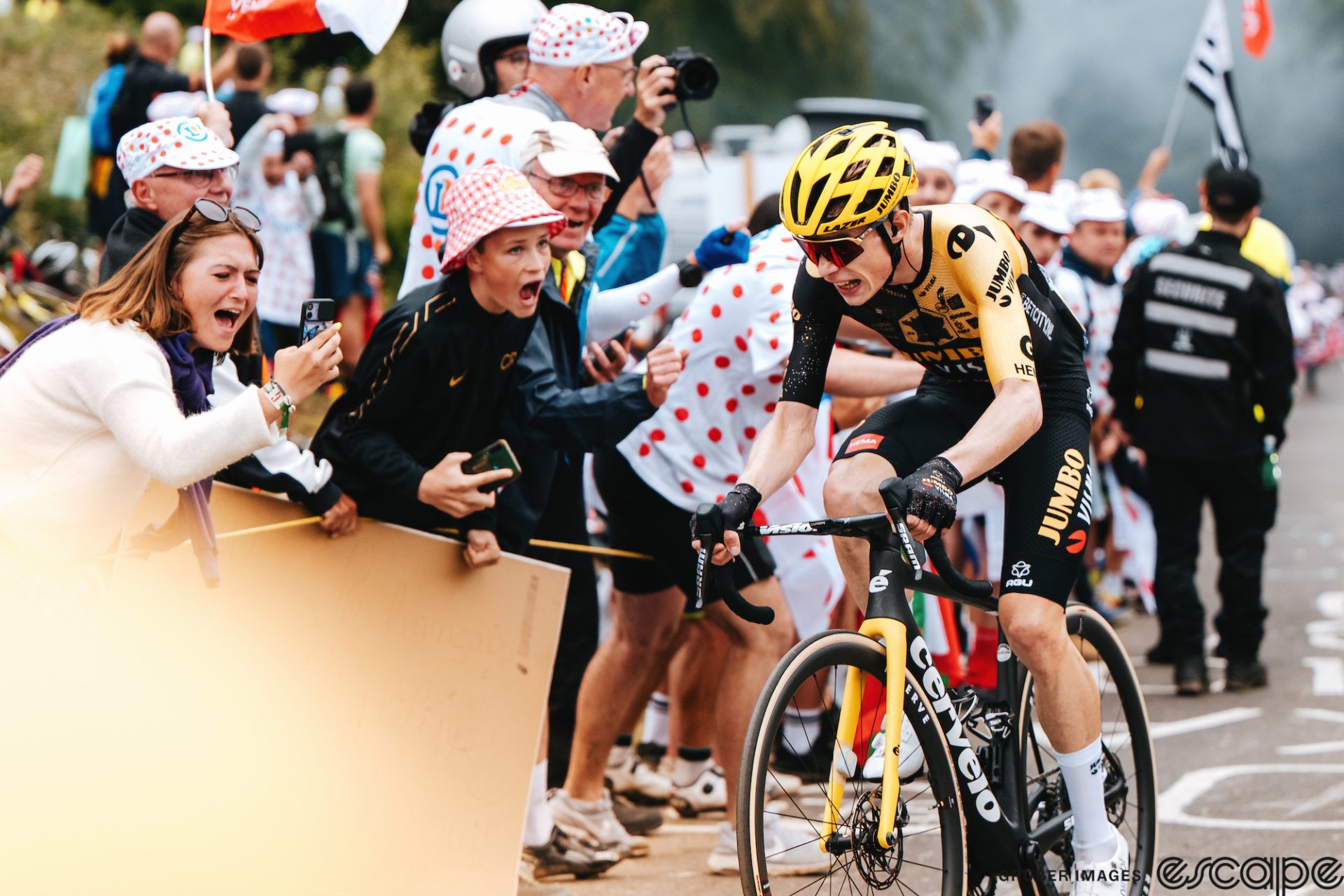Watching Tadej Pogačar attack at the 2023 Tour de France, I’m reminded of a scene from The Matrix: Reloaded, where Keanu Reeves’ character Neo calmly fights three Matrix agents with one hand literally behind his back. One succeeds in grabbing his wrist, causing him to pause and remark, “Hmm; upgrades,” before handily beating the crap out of all three and flying off.
In 2021, Pogačar was unstoppable, romping his way to three stage wins and a massive 5:20 margin on overall time to runner-up Jonas Vingegaard. And through the first 10 stages of the 2022 edition things looked to be going in a similar direction. Then Jumbo-Visma put the race on its head, and Pogačar on his back, with its tactically perfect execution of stage 11. The gap was obvious: Pogi is more explosive; Vinny is better on long climbs.
In the 11 months since the Tour, each has been working on his area of relative vulnerability. But there’s another pattern emerging for Pogačar, and it’s one that may shape the final, crucial stages of the race: he’s swapped his swashbuckling long-range moves for more calculated use of his explosive power, and it’s paying dividends.

We first saw it on stage 6, where he surprised Vingegaard with an attack on the Cauterets climb, almost three kilometers from the line. On stage 9’s finish on Puy de Dôme, it surfaced again, this time with a late move inside the final kilometer. And finally, stage 13’s finish on Grand Colombier saw him accelerate inside the final 500 meters.
The stage 6 move was his most successful in terms of time gains, but also the outlier, a kind of sneak attack that recalled the bold Pogi of past years. Jumbo had controlled the action most of the day and obviously hoped to strike another blow like it had the day before, but Pogačar literally got the jump on them. But stages 9 and 13 saw the new tactic in full, as Pogačar put his UAE Team Emirates pals to work to lift the pace and try to burn off Vingegaard’s teammates, essentially pre-empting Jumbo’s efforts to do the same, and set up Pogačar for a late attack.
“The tactic today was simple,” said UAE manager Joxean Matxin at the finish of stage 13. “Try to attack with Adam before [Jumbo] pulled, but then they pulled with Sepp [Kuss] and he was really impressive to close the gap.” Still, the plan was always based on a late attack, Matxin said, “a big long sprint with the power he had. We have four seconds, and the four seconds bonus; we are satisfied.”

This new approach may be less physical than mental; what makes it work is Pogačar’s newfound patience. Last year he was aggressive early and often, and may have paid for that in the second half of the race. This Tour, he’s watched and waited, opting to make a single hard attack late in the race. That’s been a common GC tactic the past decade or so, but what distinguishes Pogačar is the sustained intensity of his moves.
In past years, GC riders would make a move with one or two kilometers to go on a summit finish and then quickly shut it down once a rival held or re-caught the wheel. And on stages 9 and 13, Vingegaard was attentive and immediately responded, and was able to stay in contact. But then Pogačar just kept the pressure on. He didn’t so much distance Vingegaard as grimly, inexorably burn him off the wheel, close enough to the finish to get there before his own engine blew.
That tactic is well suited to this year’s Tour course. The worst gradients of stage 15’s Saint Gervais-Mont Blanc finish are right at the top, an excellent place to turn the screws and grab a few more seconds. Stage 17 descends after the Col de la Loze, and then finishes on the stupid-steep (18%) altiport runway at Courchevel – the perfect place for Pogačar’s sprint-y accelerations.
Even Saturday’s 14th stage is a good candidate for the approach. Again, the steepest portions of the final climb, the Col de Joux Plane, are near the top, and Pogačar will not shy away from some zesty descending on the high-speed, technical drop to Morzine.

Vingegaard, however, is not without defense or opportunity. For one, he’s pretty good at going down a hill himself, as he showed on the stage to Laruns. And the descent of the Joux Plane doesn’t immediately follow the summit; there’s a broad, flattish saddle of just over three km. Any high-intensity attack high on the Joux Plane could be neutralized there, wasting watts. Stage 20, to Le Markstein, is even less straightforward, with eight km of lumpy and flat terrain between the top of the Col du Platzerwasel and the finish.
“We were happy to let them take control of the stage,” said Kuss at the stage 13 finish. The day unfolded about like Jumbo expected, he said. “We knew [UAE] would ride a good pace, and on a climb like this it’s not so necessary to have the whole team there. Even Jonas could do it on his own if that was what was necessary.” It’s worth noting that Vingegaard’s deficit to Pogačar has narrowed with each successive attack: 24 seconds at Cauterets, nine at Puy de Dôme, and just four on the road on the Grand Colombier. (Time bonuses again have proved important.)
The wild card? Tuesday’s stage 16 time trial, which features a climb that will be exquisitely hard to pace properly because the course continues slightly uphill after the summit proper. Both riders and their teams have doubtless identified that stage as an absolutely critical opportunity and vulnerability, and shaped both training and strategy around it. Which rider comes out on top is impossible to know, but it seems all but certain they’ll be 1-2.
The question is what happens around it. Can Pogačar continue to whittle away at Vingegaard’s lead? If he succeeds in taking yellow and UAE is defending, how does that change things? Vingegaard and Jumbo, of course, see clearly what’s happening, so what’s their plan to address it and how much of it relies on using super-domestiques like Kuss and Wout van Aert to neutralize UAE’s tactics? In other words: who made the most upgrades over the last 11 months, and were they software (strategy) or hardware (training)?
Finally, as always, it’s worth noting all of this relies on ability to execute the plan. It’s easy to forget in a time when even fellow pros refer to Vingegaard and Pogačar as aliens, but they’re not. As one agent says to Neo before the fight begins: “You’re still only human.”
What did you think of this story?

